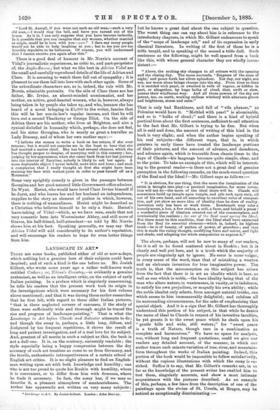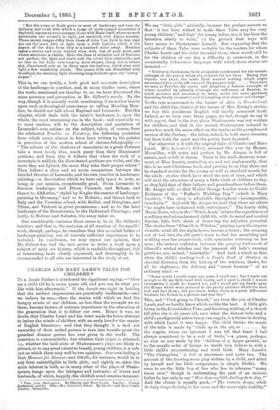LANDSCAPE IN ART.*
THERE are some books, published either of old or now-a-days, which nothing but a genuine love of their subjects could have inspired; and of such a kind is the one before us. Mr. Josiah Gilbert, who wrote some years ago a rather well-known work entitled Cadore ; or, Titian's Country,—is evidently a genuine enthusiast, as well as an intelligent critic, on the subject of early Italian painting. In a preface which is singularly unassuming, he tells his readers that the present work took its origin in the investigations which were necessary for his first volume above mentioned; and that it was during these earlier researches that he first felt, with regard to these older Italian pictures, "that in these neglected corners of canvases, if the study of them were sufficiently wide and thorough might be traced the rise and progress of landscape-painting." That is what the Landscape in Art before Claude and Salvator attempts to do ; and though the essay is, perhaps, a little long, diffuse, and disfigured by too frequent repetitions, it shows the result of long and patient investigation, and of a real love for its subject. And, greatest of all merits in such a subject as this, the book is not a dull one. It is, on the contrary, eminently readable ; the style especially being a happy compromise between the dry accuracy of such art treatises as come to us from Germany, and the febrile, enthusiastic introspectiveness of a certain school of English art critics. It is no slight pleasure to find an English- man writing upon art with both knowledge and humility; one *ho is not too proud to quote his Raskin with humility, where it is convenient, or to differ from him with firmness, where Ire finds it necessary. In fact, the essay has, if we may so describe it, a pleasant atmosphere of amateurishness. The author has apparently not written on very many subjects ;
• Lanciscare in Art. By Josiah Gilbert. London : John Marl ay.
but he knows a great deal about the one subject in question. The worst thing. one can say about him is in reference to the introductory chapters, in which Mr. Gilbert endeavours to speak
of the "scope of landscape art," and of its expression in early classical literature. In writing of the first of these he is a trifle turgid, and in speaking of the second a trifle dull. Such sentences as the following, might be well spared from a book
like this, with whose general character they are wholly incon- iiistent :—
"Above, the arching sky changes to all colours with the opening and the closing day. The moon succeeds, Empress of the noon of night,' and pours forth her silver splendour. Nor day, nor night, nor sun, nor moon alone brings change into the sky. From time to time it is mottled with pearl, or swathed in veils of vapour, or hidden in part, or altogether, by huge bulks of cloud, that, swift or slow, pursue their windborne way. And all these powers of the sky are potent, too, on earth, working endless witchery with alternate gloom and brightness, storm and calm."
That is only bad Raskinese, and full of "vile phrases," as Polonius would have it. "Mottled with pearl" is abominable, and Bo is "bulks of cloud;" and there is a kind of hybrid poetical form about the first sentences, sufficient to call attention to the fact that Mr. Gilbert is trying to be fine. Bat when all is said and done, the amount of writing of this kind in the book is very slight; and when the author begins speaking of his real subjects—the different ways, that is, in which painters in early times have treated the landscape portions of their pictures, and the amount of advance, and decadence, and advance again, which is traceable from classic times to the days of Claude—his language becomes quite simple, clear, and to the point. To take an example of this, which will be interest- ing to the general reader—is there not a great deal of genuine perception in the following remarks, on the much-vexed question of the Real and the Ideal ?—Mr. Gilbert says as follows :—
"It is obvious, for one thing, that the more the imagination of the artist is brought into play—a poetical imagination, for mere inven- tion will not do—the more of the ideal there will be. Claude will sometimes build up temple upon temple, and pile rock upon rock, all out of his own head, and all according to excellent rules of composi- tion, and yet show no more idea of ideality than he does of reality. Invention only has been at work there. Rembrandt may take a homely scene, a hut, a few stakes, a mill, a farm, and behold a poem ! a wonderful piece of idealism created out of the commonplace, and intrinsically the realistic ; for out of the Real must spring the Ideal. But there must be this condition, that the Ideal shall have extracted from the Real its essential element—which is, indeed, its highest truth—be it of beauty, of pathos, of power, of grandeur ; and that this is made the ruling thought, modifying form and colour, and light and shade, and adapting the whole composition to express it."
The above, perhaps, will not be new to many of our readers, for it is all to be found scattered about in Ruskin ; but it is clearly and, well put here, and is a truth which the majority of people are singularly apt to ignore. No error is more vulgar, in every sense of the word, than that of mistaking a wanton and an elaborate invention for true imaginative power. The truth is, that the misconception on this subject has arisen from the fact that there is in art an ideality which is base, as well as one which is noble,—the base ideality being that of the man who alters nature, in wantonness, in vanity, or in indolence, to satisfy his own prejudices, or magnify his own ability ; while the noble idealist only selects, from amongst natural truths, one which seems to him immeasurably delightful ; and subdues all its surrounding circumstances, for the sake of emphasising that special object. And it is a sign that Mr. Gilbert has thoroughly understood this portion of his subject, in that while he denies the name of ideal to Claude in respect of his inventive facultids, he yet grants it to the sweet peace which he sheds upon his "gentle hills and wide, still waters ;" for "sweet peace is a truth of Nature, though rare in a combination as complete and harmonious." We have no space for analysis, nor, without long and frequent quotations, could we give our readers any detailed account, of the manner, in which our author traces each minute variation of tree, river, and mountain.
form throughout the works of Italian painting. Indeed, this portion of the book would be impossible to follow satisfac only, without the copious illustrations with which the essay is en- riched. Suffice it to say, that Mr. Gilbert's remarks are, in so far as the knowledge of the present writer has enabled him to test them, singularly accurate, and show a most intimate acquaintance with the pictures described. As an example of this, perhaps, a few lines from the description of one of the paintings upon the shrine of St. Ursula, at Bruges, may be noticed as exceptionally discriminating :—
"But the scene at Basle gives us most of landscape, and here the delicacy and troth with which a range of snow-capped mountains is depicted, argues an acquaintance, if not with Basle itself, where no such mountains are actually in sight, yet certainly with Alpine scenery. These snowy ranges differ from those of John Van Eyck in that they are not the mere dots of light upon a wide horizon, which is the aspect of the Alps from fifty to a hundred miles away. Memlinc takes a nearer and more limited view, with less of pure snow, and where structure is visible. Here the lines of striation and of fracture are perfect, the light and shade and the aerial tints admirable, and no less so the faint over-topping snow-shapes, rising into a serene sky, illuminated only as by dawn upon the horizon, which rims with light a few wandering clouds. The nearer hills are diversified with woodland, the morning light throwing long shadows upon the ' lawny ' slopes."
This is, we can testify, a both good and accurate description of the landscape in question, and, in many similar cases, where the works mentioned are familiar to us, we have discovered the same accuracy and perception in Mr. Gilbert's words. By the way, though it is scarcely worth mentioning, if an author insists upon such archmological correctness as calling Memling Mem- linc, he should not talk about Raphael and Leonardo. But this chapter, which deals with the latter's landscape, is, upon the whole, the most interesting one in the book ; and especially so, to most readers, will be the description and quotation of Leonardo's own notions on the subject, taken, of course, from the celebrated Treatise on Painting, the following quotation from which seems almost to have been written by the painter in prevision of the modern school of chromo-lithography :— " The colours of the shadows of mountains at a great distance take a most lovely blue, much purer than their illuminated portions, and from this it follows that when the rock of a mountain is reddish, the illuminated portions are violet, and the more they are lighted, the more they take their proper colour." Then follows a close and an acute comparison between the detailed theories of Leonardo, and his own practice in landscape- painting,—a description which we have only space to note, as being, in our opinion, exceptionally good. From Leonardo to German landscape, and Darer, Cranach, and Beham, and thence to Altdorfen," styled by Kugler the creator of landscape.
painting in Germany," and so to Holbein ; and thence back to Italy and the Venetian school, with Bellini, and Giorgione, and Titian, and Tintoret in great prominence ; and so to the later landscape of the Renaissance, to the Italianised Flemings ; and lastly, to Rabens and Salvator, the essay takes us.
One considerable omission there seems to be in Mr. Gilbert's treatise; and that is, the omission of all mention of Zuccarelli's work, though, perhaps, he considers that this so-called father of landscape-painting was of scarcely sufficient importance to he included. In conclusion, we may repeat our opinion, that Mr. Gilbert has had the rare power to write a work upon a subject of early art history, which is readable throughout, full of interesting facts clearly expressed, and thoroughly to be recommended to all who are interested in the study of art.







































 Previous page
Previous page